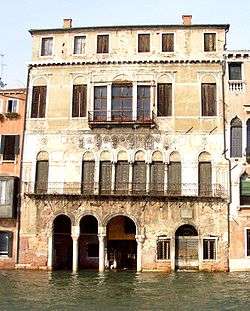Ca' da Mosto

The Ca' da Mosto is a 13th-century, Venetian-Byzantine style palace, the oldest on the Grand Canal, located between the Rio dei Santi Apostoli and the Palazzo Bollani Erizzo, in the sestiere of Cannaregio in Venice, Italy.
History
The palace has high narrow arches and distinctive capitals. The features show its beginnings as a casa-fondaco, the home and workplace of its original merchant owner. A second floor was added at the beginning of the sixteenth century, and a third in the nineteenth.
The palace dates from the early 13th-century, and takes its name from the Venetian da Mosto family, the most famous of whom was Alvise Cadamosto, an Italian explorer who worked with slave traders in Portugal, and who was born in the palace in 1432. It stayed in the da Mosto family until 1603, when Chiara da Mosto left her entire estate to Leonardo Donà dalle Rose of the Donà family, a nephew of her second husband, rather than to her da Mosto relatives, with whom she had fallen out.[1]
Between the 16th and the 18th centuries the Ca' da Mosto housed the well-known Albergo Leon Bianco (the White Lion Hotel). In 1769 and 1775 the Holy Roman Emperor and son of Maria Theresa, Joseph II, lived here during his stay in Venice.
Present day
The Ca' da Mosto currently sits empty, with the high waters of the canal having breached its basement. According to an interview in The Lady, the palace is admired by Francesco da Mosto, a descendant of its eponymous former owners, and is the Venetian building he would most like to see restored.[2]
Sources
- Francesco da Mosto, Francesco's Venice (London: BBC, 2004)
References
- ↑ Medieval and Renaissance Venice, curated by Donald E. Queller, Ellen E. Kittell, Thomas F. Madden, article on Ca' De Mosto by Juergen Schultz, pages 69-86.
- ↑ "Francesco's Venice". The Lady Magazine. Archived from the original on 2006-10-03. Retrieved 2006-07-17.
Coordinates: 45°26′23″N 12°20′09″E / 45.43972°N 12.33583°E